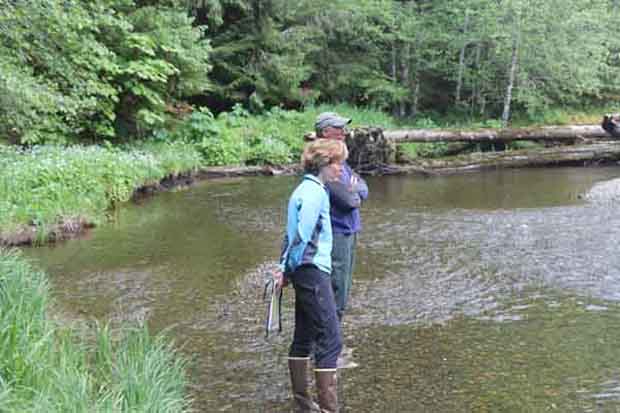 Restoring a Southeast Alaska stream
Restoring a Southeast Alaska stream
August, 2013 | by: Matt Miller, senior science writer
[dropcap]A[/dropcap]neat and tidy stream looks scenic to our eyes, suitable for calendar photos and nature blogs.
For a salmon on its spawning run, though, a neat and tidy stream is a dead end. There’s little place to rest on the long journey to the sea. There are few places to lay eggs. A lack of pools means less space for juvenile salmon that spend a year or more in freshwater.
As such, survival of young salmon drops.

The U.S. Forest Service’s Sheila Jacobson and the Conservancy’s Keith Rush monitor a restored section of Twelvemile Creek. Photo: Matt Miller/TNC
No: salmon don’t need neat and tidy. They need dead trees. They need debris. They need variety.
That’s why I’m jumping over logs with U.S. Forest Service biologist Sheila Jacobson and hydrologist Sean Claffey. They’re putting dead wood back in Twelvemile Creek on Prince of Wales Island and measuring the impact of the practice on salmon and other native fish.
Salmon have long defined Prince of Wales Island and the Tongass National Forest. Bears, bald eagles and other wildlife feed heavily on their carcasses. For thousands of years, salmon meat has been vital both nutritionally and culturally for the Tlingit and Haida communities. More recently, salmon has supported commercial and recreational fisheries.
For the past several decades, Prince of Wales Island has also been defined by logging. Cutting old growth forests affects streams in ways both predictable and unexpected. Large trees take up a lot of moisture from the island’s frequent rains (it’s a temperate rainforest). When a large amount of a watershed is logged, it can increase small floods and change stream channels. Logging also brings roads and associated road culverts, which can also increase erosion and divert streams from their natural paths.
Another practice had an unintended consequence. Prior to the mid-1980s, even biologists practiced “stream cleaning” under agency direction. Although it may sound positive, stream cleaning involved removing logs and large wood, which in turn removed pools, hiding areas and fish habitat. The good intentions of that practice were unfortunately based on poor assumptions, not science.
“A stream without dead wood becomes shallow and uniform, which leaves little habitat for fish,” says Sheila Jacobson. “These streams can’t live without wood. For their entire existence, the wood has provided habitat and nutrients, and the fish evolved with that.”
As time passes, the stream without large wood becomes wider and more unstable, making it less suitable for fish. Jacobson calls streams in this condition “bowling alleys”: they’re straight and flat.
To read complete story click here […]






